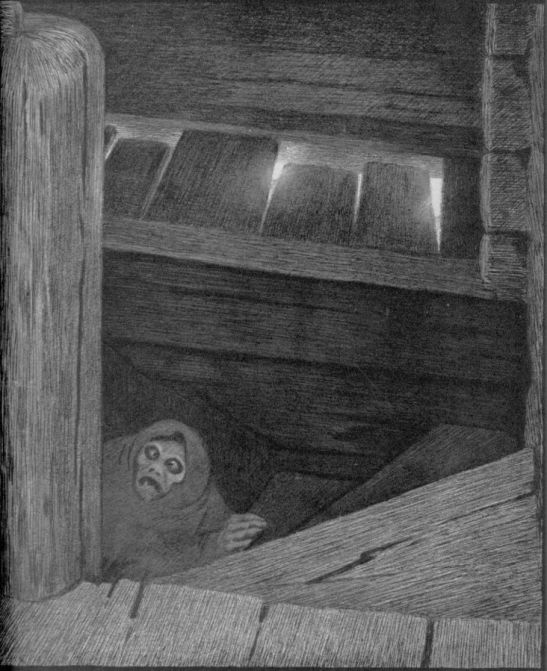Svartedauden: The Black Death in Norway
In the Summer of 1349, Magnus Eriksson, King of Norway and Sweden, wrote to his subjects appealing to them to offer prayers, to fast, and to pay a penny to the King, “for God’s sake”, because, “God has cast a great plague on the world with brutality”. Norway, like the rest of Europe, was in the grip of an advancing plague wave, the Black Death, or Svartedauden in Norwegian.
Originating in the Asian steppes, the Black Death had spread from the Black Sea region into Europe carried by Genoese traders who fled from Kaffa in 1347 (modern day Feodosiya) after plague broke out in the city during the autumn of 1346, and to escape the besieging forces of the Mongol khanate of the Golden Horde. Their arrival in Sicily, where the plague is attested from October 1347, presaged the rapid spread of the Black Death throughout Europe during the following three years.
Its entry into Norway is likely to have happened in at least two locations. In 1348 plague appeared in Oslo, presumed to have been carried by a ship from the already plague stricken south-eastern area of England. The onset of winter halted its progress, but the plague reappeared in the spring of 1349 and spread inland and along both sides of the Oslofjord.
A second plague front was introduced to Norway in July of 1349 when a ship, probably from King’s Lynn in England, docked at Bergen. All on board died, and without effective quarantine measures the plague entered Bergen from where it rapidly spread along the coast and inland, reaching Trondheim by September. By the end of 1349 all Norway had been affected, and its introduction to Oslo appears to be the originating point for the plagues advance into Denmark, Sweden, and other Baltic coastal areas following the routes of Hanse merchants as they fled to their home towns or other Baltic ports.
In Norway, mortality resulting from the Black Death was high. Icelandic annals reported that just one-third of the Norwegian population survived. Accurate figures, both for mortality rates and for Norway’s pre-plague population are hard to confirm, but available evidence supports the contemporary impression that the disease devastated the population.
Among the clergy and monastic communities, religious and legal obligations to provide pastoral care to the sick and sacraments to the dying exposed priests and monks to the plague. Mortality was consequently high. Of five bishops, just one survived. The last recorded casualty of the 1349 outbreak in Norway was the bishop of Stavanger, Guttorm Pålsson, who died on January 7, 1350. By 1371, the bishop of Trondheim, Trond Gardarsson, was clearly still experiencing the effects of the Black Death in his diocese when he wrote to pope Gregory IX that where there had been 300 priests before 1349, there were now only 40.
Of the fourteen lagmannen, officials appointed by the Crown to act as judges and to preside at the higher courts, the lagtings, only two survived the plague. A reflection of their high risk of exposure to infection as a result of their public duties. By the end of the fourteenth century the number of noble families had been much reduced, from 300 to 60. An effect of both mortality resulting from plague, and the resulting decline in wealth and the economy that followed, which saw many noble families reduced in status. Those families that did weather the storm benefited in the longer term, as wealth and power became entrenched in fewer hands.
The mortality rate among other classes among the Norwegian population is difficult to accurately ascertain due to the lack of adequate census records. Those records that survive throughout Europe are incomplete and focus primarily on societal elites. While ecclesiastical, manorial, and court records provide evidence of mortality rates among the clergy, nobility, and householders, they do not offer us anywhere near a complete picture of mortality among other household members, and the poorer members of rural and urban society.
What is clear, is that the spread of the Black Death closely followed human communication routes, both by sea and by land, regardless of the non-human causes of the plague itself, whether flea-borne as in the popular theory of bubonic plague spread by rat fleas; or airborne, as proposed by many in the fields of medicine and history. The entry of plague into Norway via shipping routes is clearly established, as it is elsewhere in Europe, and coastal trade through Norway would have contributed to the its advance. The rapid inland spread of the plague in Norway during the summer and autumn of 1349 may be explained by the widespread practice of itinerant agricultural labour, and the movement of goods and people between centres of population.
Norwegian rural communities were characterised by densely populated farms with close contact between individuals. Dwellings often consisted of a single room where all members of the household would congregate in close proximity, while many farmsteads were clustered together. This concentration of population in rural areas would favour transmission of the plague, and evidence suggests that in Norway the highest impact was on the farms at lower elevations where the population density was higher, and which were located on trade routes.
An ameliorating factor on the spread of plague in rural communities may have been the widespread practice of seterbruk, a Norwegian approach to transhumance in which livestock are moved from the permanent farm settlement to free grazing grounds on higher ground, that kept some workers away from the farms for several months. This is likely to have only offered a temporary respite, as seterbruk would typically end in September. In 1349, the returning workers would have come back to farms already affected by the plague.
A long held consensus on the effect of the Black Death puts the European death toll at 20-30 per cent of the population. This does not accord with the Icelandic annalists comment that just one-third of the population of Norway remained alive. More recent studies have placed a greater focus on rural communities, rather than special, often urban, social groups and elites. The findings suggest that throughout Europe mortality rates were significantly higher than previously thought. An estimated 60 per cent of the European population may have died during the Black Death. In bald numbers, that amounts to some 50 million people.
Pre-plague estimates put Norway’s population at 300,000 to 400,000. A 60 per cent mortality rate would give a Norwegian figure for plague deaths of between 180,000 and 240,000 thousand. When placed against a pre-existing background of population decline the impact on Norway’s subsequent development was devastating. An estimated population of 125,000 in the 1550’s strongly suggests that, two centuries later, the population had still not recovered from the catastrophe of the Black Death.
As elsewhere in Europe, the Black Death in Norway was followed by a period of decline. Administrative, legal, and military systems were weakened by the loss of skilled persons and their replacement with the unskilled. The Church had little option but to grant benefices to those who would normally not have qualified, for example by being under-age or previously disqualified by bastardy. The income of tithes was reduced by a half, and Church and monastic estates went into decline.
The nobility and the Crown equally saw reductions in their income and the value of their lands. The parlous state of the Crown is in evidence from an inventory of Blanka, the Queen-consort’s, possessions on her death in 1363; a paltry catalogue that lists, “a couple of table cloths which have often been on the table, and a pair of sheets which have often been on the bed; some velvet and other cloth; some pepper, ginger, and cinnamon; a few table knives and four silver spoons”.
Industry and commerce were affected, with the greatest impact being on agriculture. The scarcity of labour reduced the ability of landowners and tenant farmers to cultivate land, while enabling workers and tenants to demand better terms. Land prices fell dramatically, and the margin of cultivation receded for at least two centuries, as previously cultivated land, particularly at higher elevations, returned to waste and wilderness. An estimated quarter of all farms were still untenanted by the sixteenth century. Exacerbating the situation were the poor agricultural conditions that exist in much of Norway which made cultivation in many previously marginally productive areas untenable when faced with a chronic labour shortage.
As a result, Norway’s national capital may have been reduced by up to two-thirds, seriously weakening the state and limiting the Crown’s ability to raise money and to finance development and military activity. The long term effects of this may be seen in Norway’s increasingly junior position within the Kalmar Union that united Norway, Sweden, and Denmark from 1397 to 1523.
Like the rest of Europe the devastating effect of the Black Death upon the population of Norway had immediate, and long lasting effects which hampered its development for two centuries at least. Its influence in popular culture persisted far longer. A later Norwegian tale tells of a hunter in the woods, whose arrow flies into the trees only to strike the bell of a hidden and long lost parish church revealing a village left empty after the plague had claimed the inhabitants, and where a bear lies asleep in front of the altar.
Another tale, that first appears in print in 1735, is that of Jostedalsrypa. In its earliest form it tells of a community that wished to escape the plague in 1348 and retreated to an uninhabited valley where they founded the village of Jostedalen. Much like the Red Death of Edgar Allen Poe’s short story, seclusion proved to be no protection from disease and all the villagers died bar one, a girl, known as Jostedalsrypa, who was discovered living wild in the secluded valley and was eventually caught and reintroduced to civilized life. Subsequent versions of the story of Jostedalsrypa added embellishments to the tale, with the most recent, dating from 1939, suggesting that Queen Victoria was descended from the little wild girl of the Jostedal valley.
While such tales have no basis in documented history, their persistence in Norwegian memory attest to a deeply rooted folk memory of the impact of the Black Death that has echoed down the generations, and which point to the extent of the catastrophe visited upon Norway, and its long-lasting consequences.

Pesta, the personification of the Black Death in Norwegian Folklore, by Theodor Kittelsen, 1896 (Public Domain)
______
References:
Benedictow, Ole J. “The Black Death: The Greatest Catastrophe Ever.” History Today 55, no. 3 (March 2005): 42-49.
Brothren, James A. “Population Decline and Plague in Late Medieval Norway.” Annales de Demographie Historique (1996): 137-149.
Buerger, Sandra. “Pesta: The Personification of the Black Plague in Norway”. Myths and Microbes. https://mythsandmicrobes.com/2016/09/29/pesta-the-personification-of-the-black-plague-in-norway/
Cohn, Samuel K. “The Black Death: End of a Paradigm.” American History Review (June 2002): 703-738.
Derry, T. L. A Short History of Norway. London: George Allen & Unwin, 1960.
“Etter Jonas Ramus (1715): Segna om Jostedalsrypa”. Jostedal historielag. http://www.historielaget.jostedal.no/?page_id=33
“Etter Melchior Yttri (1939): Jostedals-Rypen.” Jostedal historielag. http://www.historielaget.jostedal.no/?page_id=41
Larsen, Karen. A History of Norway. Princeton, NJ: Princeton University Press, 1948.
“Svartedauden”. Norgeshistorie.no. https://www.norgeshistorie.no/senmiddelalder/mennesker/1001-pesten-kommer.html
“Svartedauden.” Wikipedia. https://no.wikipedia.org/wiki/Svartedauden


Pingback: When the Black Death stalked midnight’s lands – CRYOPOLITICS
I am a student at the University of Vermont in the United States a d doing a research project on the artwork of the black death in Norway. I would love to ask you a few questions!
LikeLike